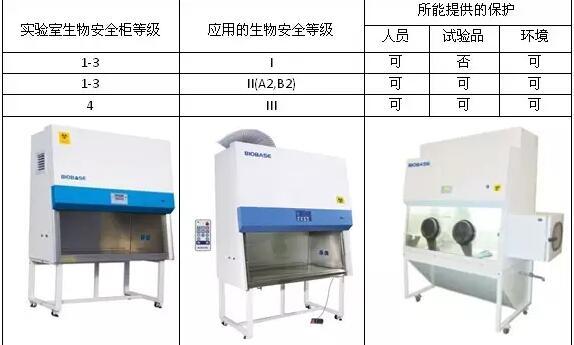The biosafety cabinet provides both sample and staff protection. The filtered clean air stream is blown from the top of the safety cabinet and passed through the work area and captured before the worker's breathing zone. The airflow will be filtered before it is vented. Normally the filtered air will be discharged back to the laboratory or discharged outside through the exhaust duct. Biosafety cabinets for biosafety levels: Classification and function of biological safety cabinets: The biological safety cabinet is divided into Class I, Class II and Class III biological safety cabinets; Class II biological safety cabinets are further divided into A2 type and B2 type. The biosafety cabinet has the following functions: Class I biosafety cabinets provide protection for personnel and the environment, but do not provide protection for the sample, are often used as special sealing equipment (such as centrifugation), or may operate with aerosols. Class II biosafety cabinets provide protection for people, the environment and samples. The B2 is a fully vented biosafety cabinet with no air circulating in the cabinet to provide basic biological and chemical protection. Class III biosafety cabinets provide maximum protection for people, the environment and samples for the manipulation of microorganisms or pathogens of Class 4 biosafety levels. Correct selection of biosafety cabinets: When choosing a biosafety cabinet, the laboratory should know in detail the main elements involved in the biosafety level in the work of infectious microbes, and select different levels of biosafety cabinets according to the protection provided to individuals, the environment and society. Class I Biosafety Cabinet: Protects workers and the environment without protecting samples. The airflow principle is the same as for a laboratory fume hood, except that the vent is fitted with a HEPA filter. All types of biosafety cabinets use HEPA filters in the exhaust and air intakes. The first-class biological safety cabinet itself has no fan, and relies on the fan in the external ventilation pipe to drive the airflow. Since it cannot provide protection for the test articles or products, it has been used less frequently. Class II biosafety cabinet: It is the most widely used cabinet type. Like Class I biosafety cabinets, Class II biosafety cabinets also have airflow into the front window opening, known as the “inlet airflowâ€, to prevent aerosols that may be generated during microbial operations from escaping from the front window. Unlike Class I biosafety cabinets, the unfiltered intake air stream is captured by the incoming grid before reaching the work area, so the test product is not contaminated by outside air. A unique feature of the Class II biosafety cabinet is that the vertical laminar airflow filtered through the HEPA filter is blown from the top of the safety cabinet and is referred to as the "downward flow." The sinking airflow is continuously blown through the working area of ​​the safety cabinet to protect the test items in the cabinet from external dust or bacteria. Class III Biosafety Cabinet: Designed for Class 4 laboratory biosafety levels, it is the world's highest safety level safety cabinet. The cabinet is completely airtight, 100% fully exhausted, all gases are not involved in the cycle, the staff operates through the gloves attached to the cabinet, commonly known as the glove box (Golve box), and the test products enter and exit the safety cabinet through the double-door transfer box. Ensure that it is free of contamination and is suitable for high-risk biological tests. Xin Beisi biological safety cabinet factory direct hot line 15851187703 Safety Box,Home Safe,Large Safe Box,Exclusive Safes Hebei Yingbo Safe Boxes Co.,Ltd , https://www.ybsafebox.com